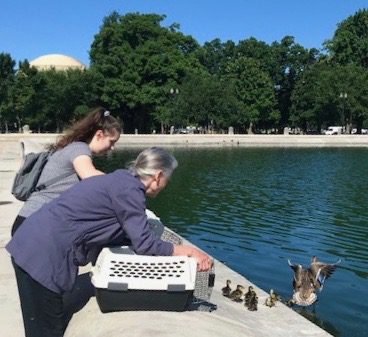City Wildlife to the Rescue
By • June 13, 2022 0 2443

At a fancy condo building by the C&O Canal in Georgetown, everyone knows their job. Starting in early spring, the people living on the ground floor, who have enclosed courtyards, look for new mallard nests.
When the ducklings hatch, everyone swings into action. If the downstairs neighbors go out of town, the upstairs neighbors peer over their balconies, keeping an eye on the babies. Duck Watch volunteers get ready — the ducklings can’t fly, can’t get out of the fenced-in yards, and if they can’t get to water, they’ll die.
When the Duck Watch volunteers show up with crates to rescue the babies, even the mother ducks, who’ve been nesting at the building for several years, know their role. They follow. Then volunteers and building residents take the ducklings to a nearby release site and watch the family take their first group swim.
They are architects, retired park rangers, government employees, and teachers, but that’s in their spare time. What they really do is rescue mother ducks and their babies, push to keep migratory and other birds safe in downtowns glass canyons, and care for baby squirrels and bunnies.
This is City Wildlife, an organization dedicated to helping urban creatures, and right now it holds about 200 animals or birds, in peak spring season. “We have tons of baby birds, and turtles hit by cars, with broken shells, half a dozen or more, baby rabbits. Typically, about half our wildlife are birds,” said Anne Lewis, who co-founded City Wildlife located at 15 Oglethorpe St NW in 2008. “It is really busy April through September and then it really drops off around November, and that’s when we get to do the administrative stuff and paint the office.”

Capitol Reflecting Pool, Washington D.C., May 14, 2017. Photo by Jeff Malet (not Jeff Mallard).
Now, though, City Wildlife is too busy rescuing the animals we Washingtonians live with. Lights Out DC and Duck Watch are two of City Wildlife’s most important projects. For Lights Out DC, volunteers go out in the early mornings to the 14 or so blocks between Union Station and the Convention Center to look for birds killed flying into buildings because they can’t see the glass. Lisbeth Fuisz, who teaches in the English department at Georgetown University in her spare time, runs Lights Out. “Yes, glass is beautiful and lit buildings are beautiful, but they are deadly to birds. We have to understand there are consequences to that — what is beauty for humans is very detrimental to birds.” In the United States alone, as many as 988 million birds die annually from collisions with glass.
The D.C. Council is currently considering a bill that would require all new or substantially remodeled buildings to use glass visible to birds. “It’s a weird thing,” said Fuisz. “You don’t want to find birds because you know they’re suffering and dying, but it’s good to do something.” Lights Out has been in talks with the MLK Library about changes to its facades, and the Convention Center put film with wavy lines over some glass that was particularly dangerous” And, Fuisz says, Lights Outs saw “something like an 85 or 89 percent reduction in collisions there.”
“Ducks are really charismatic. It’s hard not to like them,” said April Linton, City Wildlife’s Duck Watch coordinator. She’s still working from home, but when she’s at the State Department’s Office of Foreign Assistance, she keeps a net and reflective vest near her desk for emergency duck calls. “I’d be dressed for the State Department, and I’d be out waving a net around the GW campus or whatever,” she said.

Lauren Lezell of Lights Out DC (left) and Alison Lewis of City Rescue (right) perform a duck release at the Capitol reflecting pool. Photo by Alison Schafer.
Duck Watch began when City Wildlife started getting calls about mallards breeding in enclosed backyards, on rooftops, high terraces, in courtyards—places where they couldn’t get their ducklings to water. City Wildlife has been called to about 40 nests this spring. Volunteers either use a net to capture the mother duck (the ducklings are easy to round up) or they use “shed capture,” like at the condo building near the canal.
“You get the ducklings first and mom will stand around, quacking, then you put them in the open crate, in a shed or someone’s living room. You put the crate in the living room — which happens all the time, people are really good sports about it — and the mom will walk into the living room, following the ducklings, and then we just shut the door and they’ve got them,” explains Lewis. It’s a high stakes operation: If the mother duck gets spooked and flies off, the orphaned ducklings “are City Wildlife’s to raise,” Lewis adds.
“I was always an animal person. I think I was born an animal person and I always had a fondness for waterfowl,” said Linton. “And when I am able to talk to people, answer questions about ducks or help them — I just think we have a responsibility to these animals and caring for them makes us better and better at caring for each other.”

